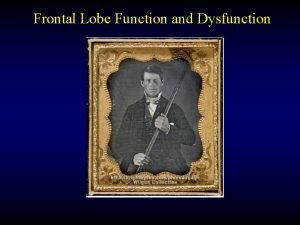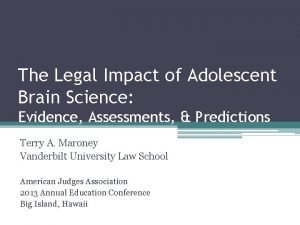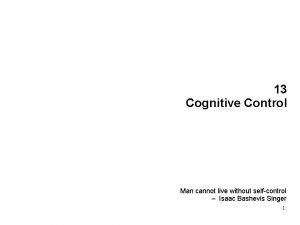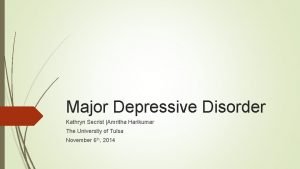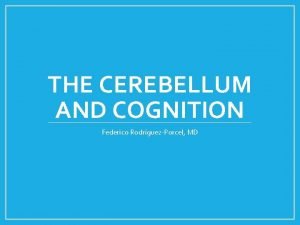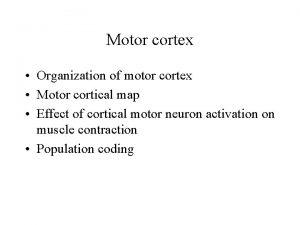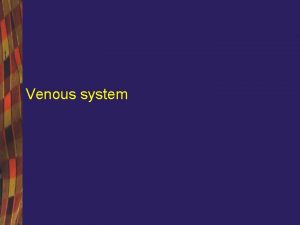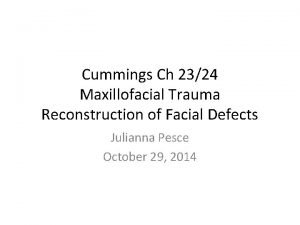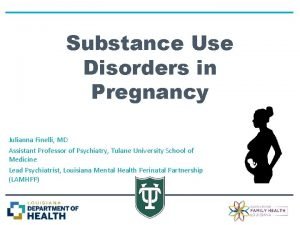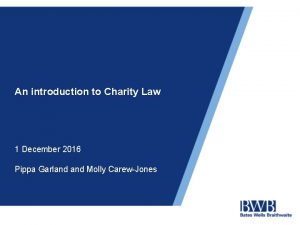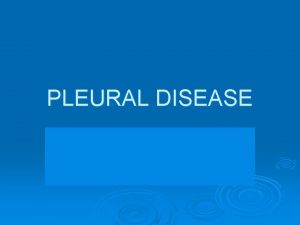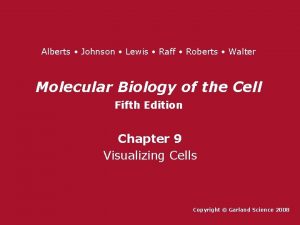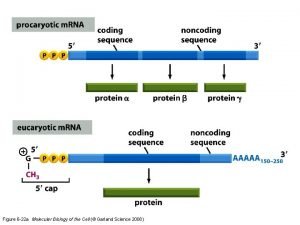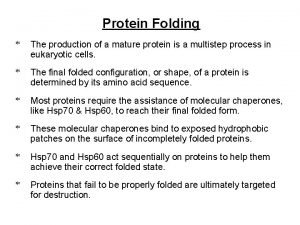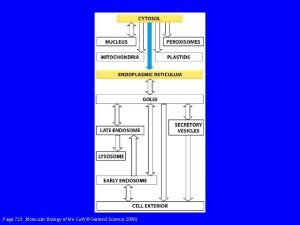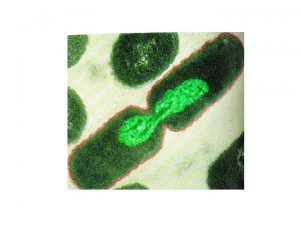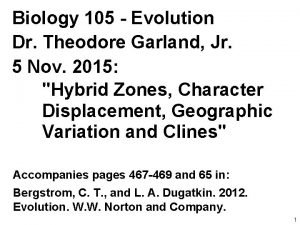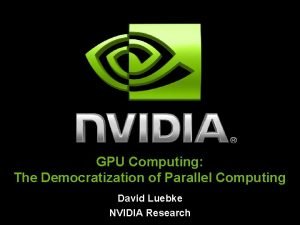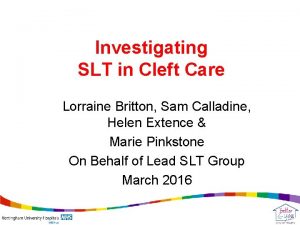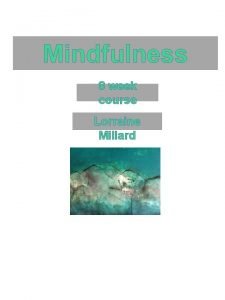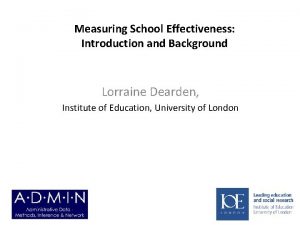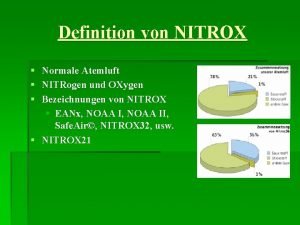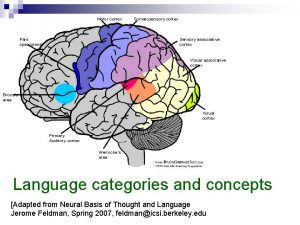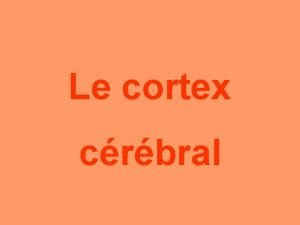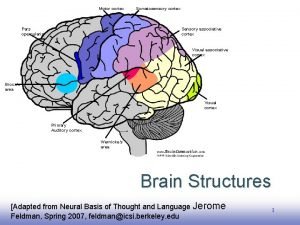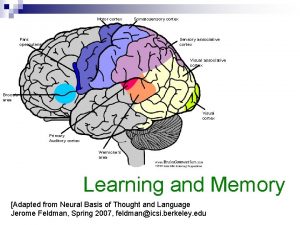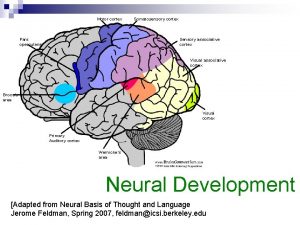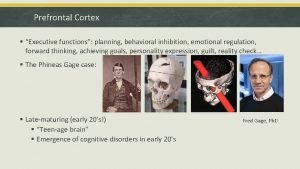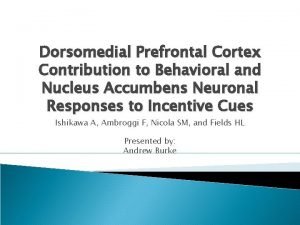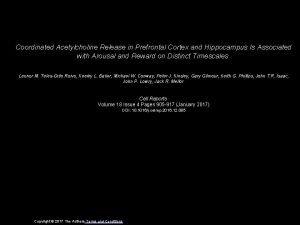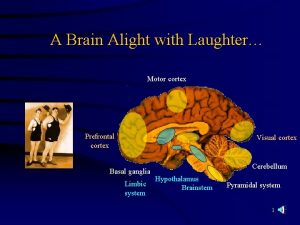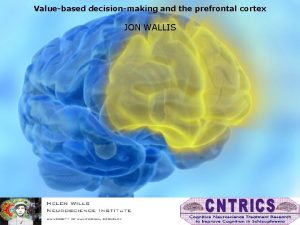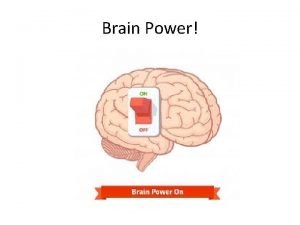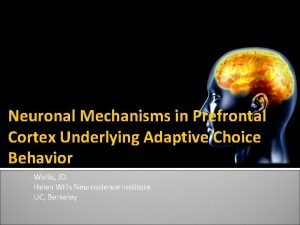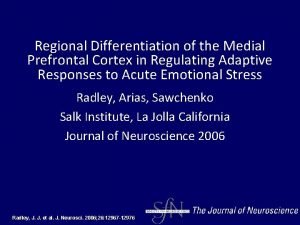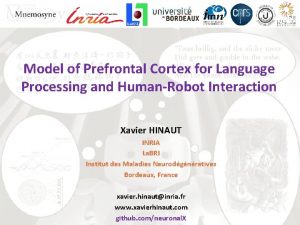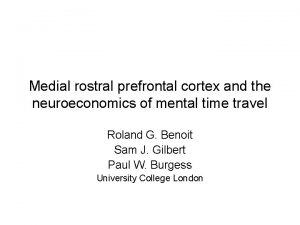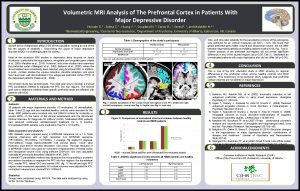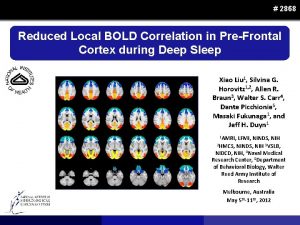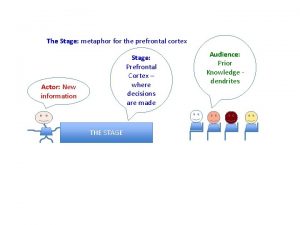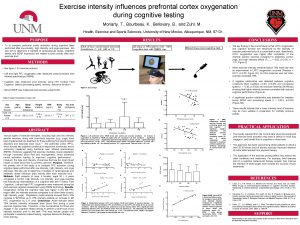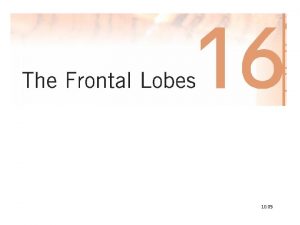Prefrontal Cortex Julianna Antonucci Sydney Delfico Lorraine Garland















































- Slides: 47

Prefrontal Cortex Julianna Antonucci, Sydney Delfico, Lorraine Garland, Danielle Renzi, Ro -anna Thomas

Prefrontal Cortex • https: //www. youtube. com/watch? v=u 76 j. Bk 5 9 RFk

Structure • anterior-most part of frontal lobe • larger in humans • Inputs from the amygdala and olfactory cortex Medial dorsal nucleus PFC • known as projection zone from medial dorsal nucleus of the thalamus (or dorsomedial nucleus of thalamus) • interconnected with much of brain; cortical, subcortical and brain stem sites • brainstem arousal systems

Structure

Structure • structure based on neurons arranged in minicolumns with incoming and outgoing connections distributed across many brain regions • in PFC minicolumns are interconnected to each other through horizontal ‘long range’ projections in L 2/3 • Mini columns in dorsolateral prefrontal cortex ‘bind’ perception and executive selection of spatial targets to guide goal-specific behavior

Brodmann areas (maps of cortical areas) of PFC includes • • • 8 Includes frontal eye fields 9 Dorsolateral prefrontal cortex 10 Anterior prefrontal cortex 11 Orbitofrontal area 44 Pars opercularis (part of the inferior gyrus & part of Broca’s area) • 45 Pars triangularis (part of the inferior frontal gyrus & part of Broca’s area) • 46 Dorsolateral prefrontal cortex • 47 Pars orbitalis (part of the inferior frontal gyrus

Structure 95% of structure of brain formed by 5/6 PFC grows again right before puberty Grey matter constantly changing throughout life, but peaks in early adolescence, and a couple years later for boys • Important because grey matter contains cell bodies and connections between cells (synapses) • so important because it deals with synaptic pruning • • •

Structure • Synaptic pruning depends on environment child in • Unused connections (unused grey matter) pruned away if certain synapses aren’t used • Pruning away synapses and wrapping myelin consolidates learning • “Use it or lose it principle” pruning process begins at back of brain; PFC remodeled last, so teens might rely more on amygdala to make decisions and solve problems “If a teen is doing; sports or academics, those are the connections that will be hard wired. If they’re lying on the couch or playing video games or MTV, those are the cells and connections that are going to survive”

Sesame Street • https: //www. youtube. com/watch? v=9 Pnb. KL 3 wu. H 4 • 0: 26 -1: 04

Function of the PFC • Function- Executive Functioning – Executive functions (also known as cognitive control and supervisory attention system) is an umbrella term for the management (regulation, control) of cognitive processes. • Functions include: Attention, memory and working memory, reasoning, task flexibility, and problem solving as well as planning and execution, judgment and evaluation, reasoning and "computation", comprehension and production of language.

Function of the PFC • Functions according to specific areas of the PFC – The dorsolateral prefrontal cortex (DLPFC)involved in "on-line" processing of information such as integrating different dimensions of cognition and behavior. – The anterior cingulate cortex (ACC)- involved in emotional drives, experience and integration, inhibition of inappropriate responses, decision making and motivated behaviors.

Function of the PFC • Functions according to specific areas of the PFC: – The orbitofrontal cortex (OFC)- involved in impulse control, maintenance of set, monitoring ongoing behavior and socially appropriate behaviors, representing the value of rewards based on sensory stimuli and evaluating subjective emotional experiences.

Development of Executive Functions – The PFC is the last section of the brain to mature. • Other brain areas are fully developed early in life, the prefrontal cortex is not until the age of 25. • The development of executive functions correspond with the development of the PFC. • Different abilities peak at different times (early or late in childhood, adolescence, or adulthood. ) • Executive function abilities are shaped by physical changes in the brain and by life experiences, in the classroom and in the world at large.

Development of Executive Functions – Executive functioning development corresponds with the neurophysiological developments. • Processing capacity of the frontal lobes and other interconnected regions increase in size= emergence of core executive functions. Thus, for every developmental stage in human development, the functions are constantly developing. • Functions do not fully mature during the early childhood, preadolescence, and adolescence stages so children will continue to make mistakes related to these emerging abilities, not because they lack the abilities but because they do not understand when and how to use these abilities. Naturally, they older they get, the more they are able to understand how and when to use these abilities.

Developmental Stages (cont’d) – Preadolescence • Children exhibit certain growth spurts in executive functions, experience a growth in verbal working memory, goal-directed behavior (with a potential spurt around 12 years of age); response inhibition and selective attention; and strategic planning and organizational skills. • Ages 8 to 10 years- cognitive flexibility starts to match that of adults.

Development of Executive Functions – Adolescence • Brain systems become better integrated= more effective and efficient use and improvement of executive functions. • Planning and goal-directed behavior experiences ongoing growth. • Attention control, with a potential spurt at 15, along with working memory continues to develop. – Adulthood • Major change= constant myelination if neurons in the PFC. • Ages 20 -29: executive functions are a their peaks. – These skills begin to decline with working memory and spatial span being the areas where decline is most readily noted. Cognitive flexibility, however, starts declining around age 70.

Phineas gage • https: //www. youtube. com/watch? v=WGl 5 SU B 8 IXM • Stop at 55 seconds

Damage to the Prefrontal Cortex The Case of Phineas Gage • First reported case of Traumatic Brain Injury (TBI) to Prefrontal Cortex • Led to personality changes “no longer Gage” • Cognitive, intellectual, and language skills intact • Ability to reason, particularly within a social context, seriously impaired • No autopsy, but skull exhumed and accident reconstructed using modern neuroimaging techniques to estimate place of injury as Ventromedial PFC

Damage to the Prefrontal Cortex • Fascinating constellations of deficits found in other patients with damage from: – TBI: Injuries from violent blow to the head, sports, falling down stairs, car crash etc. – Stroke: Interruption of blood flow to the brain – Tumors: Cancerous or noncancerous mass of abnormal cells in the brain

Damage to the Prefrontal Cortex In the left prefrontal cortex: A: MRI of acute stroke B: Coronal slice of stroke In the right prefrontal cortex: C. MRI of tumor D: Axial slice of tumor Damage often extends into multiple areas and there are substantial overlapping and interactive functions across these regions

Assessing Damage to the Prefrontal Cortex • Non-invasive technologies - f. MRI, CT, PET, EEG, MRI etc. – Assess structural damage – Measure brain activity correlated to cognition, behavior or emotion during task performance • Neuropsychological tests sensitive to consequences of localized brain damage • Two areas studied in depth – Orbitofrontal-Ventromedial – Dorsolateral

Damage to Orbitofrontal/Ventromedial PFC • Inhibitory control and decision making deficits – More risky, maladaptive decisions – Problems learning and relearning stimulusreward/punishment associations – Trouble updating behavior based on these associations in order to reach goals.

Damage to Orbitofrontal/Ventromedial PFC • Emotional and social control issues – Lack of affect or poorly modulated emotional reactions – Disinhibited or socially inappropriate behavior with social conventions ignored – Defective social and moral reasoning

Damage to Orbitofrontal/Ventromedial PFC • Theory of mind – Impaired insight and difficulty in inferring the mental states of others – Failure to use emotions to guide decisions leading to poor social decision making – Impaired recognition of emotional expressions – Inability to adjust initial judgments after receiving more information

Damage to Dorsolateral PFC • Working memory issues – Online maintenance of recent memories – Inability to rearrange, transform, or track the relative status of stimuli within working memory • Attention issues – Increased distractibility – Decreased responses to visual and auditory stimuli • Executive Function deficits – Planning, anticipation and problem solving – Goal neglect and diminished motivation – Difficulty with delaying gratification

Damage to Dorsolateral PFC • Rule learning and task switching problems Perseveration with Wisconsin Card Sorting test • Declarative memory deficits – Source memory especially for places, and famous faces – Monitoring and control of memory processes, both at the time of encoding and at the time of retrieval

Recovery of Function Following Damage to PFC • Reorganization – Intact portions may compensate for damaged area but prognosis for full recovery is poor • Compensatory cognitive retraining to learn new skill – Operant conditioning – response-cost procedure for disinhibiting issues – Portable electronic memory devices • Direct intervention to regain old skills such as attention, working memory, or goal-directed behavior – Computer based programs – Goal management techniques – Mindfulness training

ADHD • ADHD is a common neuropsychiatric disorder that affects attention, impulsiveness, and hyperactivity • Exact origin of ADHD is unknown, but ADHD has been described as neurobehavioral, neuropsychiatric and neurodevelopmental disorder

Facts about ADHD • ADHD appears more often in males (3: 1) • These behavioral issues appear before the age of 7 • Over the course of development ADHD puts those at risk for many issues in school and socially

Impairment with ADHD • Attention networks and inhibitory control networks • Inappropriate neurotransmitters levels may also impair function in the prefrontal cortex • Any slight change in levels of norepinephrine and dopamine can have lasting effects on the prefrontal cortex causing symptoms associated with ADHD

What Causes ADHD? • There is no definite cause of ADHD but scientists believe it may be a combination of risk factors – Genes – Environmental factors – Brain injuries – Sugar – Food additives

Three Subtypes of ADHD • Predominantly hyperactiveimpulsive • Predominantly inattentive • Combined hyperactiveimpulsive and inattentive

Symptoms of ADHD • Inattention – Easily distracted, can’t focus, trouble with turning in homework, losing things, day dream, issues following instructions • Impulsivity – Very impatient, inappropriate comments, interrupt others • Hyperactivity – Fidget, nonstop talking, touching everything in sight, constantly in motion

Treatments of ADHD • Medications are used – Most common is a “stimulant” – Many different types some are short-acting or long -acting • Ritalin, Focalin, Adderall – Decreased appetite and sleep problems most common – Less common tics and flat personality

Future Research on ADHD • Over time, research has shown that ADHD is not just a behavior disorder but a developmental impairment of the brain’s executive functions- the self-managing systems • Motivation and emotional regulation are major issues for those with ADHD but are not included in criteria • Need to look at overlapping disorders, to treat properly • Diagnosing females with ADHD must be separate from diagnosing males.

Schizophrenia • https: //www. youtube. com/watch? v=SN 1 GCo Vzx. Gg • 3: 00 -4: 15

Schizophrenia and the Prefrontal Cortex: Symptoms • Schizophrenia is a mental disorder associated with abnormal social behavior and delusions • Two classifications of symptoms: Positive and Negative • Positive Symptoms- Extra feelings and behaviors not normally present – Delusions and hallucinations(most commonly auditory) – Disordered thought and speech • Negative Symptoms- A lack of feelings and behaviors usually present – Flat or inappropriate expression and emotion – Speech Difficulty – Lack of pleasure, motivation, and desire for relationships • Symptoms typically being in early adulthood and reduces life expectancy by about 25 years

Schizophrenia and the Prefrontal Cortex: Possible Causes • Not a definite cause, but both environmental and genetic factors offer possible associations • Environmental factors: – Drug use- alcohol, amphetamine, cocaine, alcohol – Prenatal Stressors: illness, stress, malnutrition of mother, or being born in the spring or winter all correlated – Social Isolation or social stress • Genetics and Schizophrenia: – – Search for a gene that explains excess dopamine in cerebral cortex Those with a family member with schizophrenia have a 20 -40% of also being diagnosed Exact gene not known Observed to be associated with NOTCH 4, histone protein loci, zinc finger protein 804 A, COMT gene – COMT (Catecho-o-methytransferase) siblings and this gene – Genetics lead into the research surrounding cognitive effects and mechanisms of schizophrenia – Research surrounding gene affecting prefrontal cortex functioning

Schizophrenia and Cognition: The Role of the Prefrontal Cortex • Schizophrenia has been associated with cognitive deficits in – – working memory long term memory Attention Executive functioning • Treatments – Antipsychotic Drugs – Cognitive-Behavioral Therapy – Social Skills Training – There is no cure How is schizophrenia associated with these cognitive deficits? What is being done to better understand the relationship between cognitive effects to help refine treatments? Research is prompted by the Dopamine Hypothesis of Schizophrenia…

Gruber, Oliver, Antonella Santuccione, and Helmut Aach. "Figure 1. Example for Consequences of NMDA Receptor Hypofunction in Glutamatergic– dopaminergic Circuits. " Magnetic Resonance Imaging in Studying Schizophrenia, Negative Symptoms, and the Glutamate System. 2014 ed. N. p. : Fronteirs, n. d. N. pag. April. Psychiatry.

The Dopamine Hypothesis of Schizophrenia • Attributes psychotic effects of schizophrenia to overactive dopamine receptors • Hypothesis formed on antipsychotic research: Antipsychotic drugs used to treat schizophrenia have receptor antagonistic effects • Areas affected differ based on relationship to glutamate, where glutamate is too low, dopamine is overactive – Antipsychotics recept at 5 -HT 2 C receptor, release dopamine in several areas, including prefrontal cortex – Other areas of release involved: mesolimbic, mesocortical, Broca’s and Wernicke’s area • Prefrontal Cortex has NMDAR(N-methyl-D-aspartate receptors) that are associated with cognitive impairments, • Contains most of the dopamine sensitive neurons

Finding the Link: Schizophrenia and the Prefrontal Cortex(Lindenberg et. al, 2002) • National Institute of Mental Health research • Findings: Psychotic symptoms could be caused by reduced prefrontal cortex activation, which causes excess dopamine in striate cortex • Uses PET scan: Radioactive oxygen reveals where blood flows and indicates which brain areas are activated during working memory task, radioactive precursor chemical of dopamine indicated dopamine activity • Schizophrenic patients showed lower performance and reduced prefrontal activation

http: //neuronbank. org/wiki/index. php/Chandelier_Neuron

Schizophrenia and the Prefrontal Cortex: Where are we now? • The finding of a connection indicated that Schizophrenia could be due to a primary defect of the prefrontal cortex • Schizophrenia in diagnosis is marked by a lack of links between prefrontal cortex and areas in the cortex associated with higher-order thinking • Connection from prefrontal cortex to striate cortex is inhibitory, an offered explanation indicates that an anatomical change in the PFC in schizophrenia stops the inhibition of dopamine release. • New from Yale researchers Anticevic et. al, 2015, shows that in onset, there is an initial spike in connection, followed by a decline, current research into relationship between interaction of excitatory and inhibitory connection

References • • Spinks, Sarah. "Adolescent Brains Are Works in Progress. " PBS, 9 Mar. 2000. Web. 25 Apr. 2015. "Your Teenager’s Developing Brain. " Raising Children Network, with the Centre for Adolescent Health, n. d. Web. Opris, Loan. "Prefrontal Cortical Microcircuits Bind Perception to Executive Control. " Nature. com. Nature Publishing Group, 29 July 2013. Web. 27 Apr. 2015. Blakemore, Sarah. "The Mysterious Workings of the Adolescent Brain. " Sarah-Jayne Blakemore: . Ted Talks, June 2012. Web. 27 Apr. 2015 "Prefrontal Cortex. " Wikipedia. N. p. , n. d. Web. Barkley, R. A. (1997). Behavioral inhibition, sustained attention, and executive functions: Constructing a unifying theory of ADHD. Psychological Bulletin, 121(1), 65 -94. doi: 10. 1037/0033 -2909. 121. 1. 65 Nikkelen, S. C. , Valkenburg, P. M. , Huizinga, M. , & Bushman, B. J. (2014). Media use and ADHD-related behaviors in children and adolescents: A meta-analysis. Developmental Psychology, 50(9), 2228 -2241. doi: 10. 1037/a 0037318 • Attention Deficit Hyperactivity Disorder (ADHD). (n. d. ). Retrieved April 22, 2015, from http: //www. nimh. nih. gov/health/topics/attention-deficit-hyperactivity-disorder-adhd/index. shtml • Researchers on ADHD Research. (n. d. ). Retrieved April 21, 2015, from http: //www. chadd. org/Understanding-ADHD/Parents-Caregivers-of-Children-with-ADHD/Symptoms-and. Causes/Researchers-on-ADHD-Research. aspx

References • Damasio, H. , Grabowski, T. , Frank, R. , Galaburda, A. M. , & Damasio, A. R. (2005). The Return of Phineas Gage: Clues about the Brain from the Skull of a Famous Patient. In J. T. Cacioppo, G. • G. Berntson, J. T. Cacioppo, & G. G. Berntson (Eds. ), (Key reading in social psychology, pp. 21 -28). New York, NY, US: Psychology Press. • Szczepanski, S. M. , & Knight, R. T. (2014). Insights into human behavior from lesions to the prefrontal cortex. Neuron, 83(5), 100218. doi: http: //dx. doi. org/10. 1016/j. neuron. 2014. 08. 011 • http: //www. theguardian. com/commentisfree/2015/mar/17/missouriexecuting-cecil-clayton-missing-a-part-of-hisbrain? CMP=share_btn_link • Executive functions. (n. d. ). Retrieved April 25, 2015, from http: //en. wikipedia. org/wiki/Executive_functions

• • References Anticevic, Alan, et al. "Early-Course Unmedicated Schizophrenia Patients Exhibit Elevated Prefrontal Connectivity Associated with Longitudinal Change. " The Journal of Neuroscience 35. 1 (2015): 267 -286. "Dopamine Hypothesis of Schizophrenia. " Wikipedia. Wikimedia Foundation, n. d. Web. 23 Apr. 2015. Gruber, Oliver, Antonella Santuccione, and Helmut Aach. "Figure 1. Example for Consequences of NMDA Receptor Hypofunction in Glutamatergic–dopaminergic Circuits. " Magnetic Resonance Imaging in Studying Schizophrenia, Negative Symptoms, and the Glutamate System. 2014 ed. N. p. : Fronteirs, n. d. N. pag. April. Psychiatry. Hathaway, Bill. "Too Much of a Bad Thing: Schizophrenia Onset Linked to Elevated Neural Links. " Yale News. Yale University, 6 Jan. 2015. Meyer-Lindenberg, Andreas, Robert S. Miletich, Philip D. Kohn, Giuseppe Esposito, Richard E. Carson, Mario Quarantelli, Daniel R. Weinberger, and Karen Faith Berman. "Reduced Prefrontal Activity Predicts Exaggerated Striatal Dopaminergic Function in Schizophrenia. " Nature Neuroscience 5. 3 (2002): 267 -71. "NIH News Release-Gene Slows Frontal Lobes, Boosts Schizophrenia Risk" U. S National Library of Medicine. U. S. National Library of Medicine, 29 May. 2001. "Schizophrenia. " Wikipedia. Wikimedia Foundation, n. d. Web. 23 Apr. 2015.
 Dorsolateral prefrontal cortex function
Dorsolateral prefrontal cortex function Prefrontal cortex development by age
Prefrontal cortex development by age Prefrontal cortex and amygdala
Prefrontal cortex and amygdala Prefrontal and frontal cortex
Prefrontal and frontal cortex Amritha harikumar
Amritha harikumar Dorsal lateral prefrontal cortex
Dorsal lateral prefrontal cortex Motor cortex sensory cortex
Motor cortex sensory cortex Reguli laborator informatica
Reguli laborator informatica Carl antonucci
Carl antonucci Paolo antonucci
Paolo antonucci Kortikal asosiyasyon alanları
Kortikal asosiyasyon alanları Hemihypestesia
Hemihypestesia Julianna barnes
Julianna barnes Kamil szadkowski srednia
Kamil szadkowski srednia Julianna református iskola
Julianna református iskola Dr gellért julianna
Dr gellért julianna Tarsoly julianna
Tarsoly julianna Dr tarsoly julianna
Dr tarsoly julianna Dr julianna pesce
Dr julianna pesce Julianna finelli
Julianna finelli Pippa garland
Pippa garland Hypersonority
Hypersonority Garland science 2008
Garland science 2008 Tecta america zero company
Tecta america zero company Garland science 2008
Garland science 2008 Enzyme-linked receptor
Enzyme-linked receptor Garland manufacturing company
Garland manufacturing company Traslocone sec
Traslocone sec Somewhere over the rainbow judy garland
Somewhere over the rainbow judy garland Garland key dead cells
Garland key dead cells Present homophone
Present homophone Six sigma garland
Six sigma garland Theodore eugene garland
Theodore eugene garland Michael garland nvidia
Michael garland nvidia Garland library catalog
Garland library catalog Biology 10
Biology 10 Lorraine forrest-turner
Lorraine forrest-turner Housing counselor certification
Housing counselor certification Lorraine becerra
Lorraine becerra Lorraine britton
Lorraine britton Lorraine millard
Lorraine millard Lorraine dearden
Lorraine dearden Lorraine smith effekt
Lorraine smith effekt Baeckeoffe pronunciation
Baeckeoffe pronunciation Dr lorraine johnstone
Dr lorraine johnstone Lorraine faulds
Lorraine faulds Dr lorraine johnstone
Dr lorraine johnstone Facts about lorraine hansberry
Facts about lorraine hansberry
